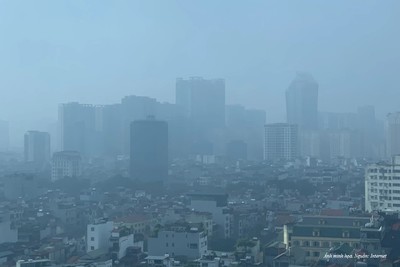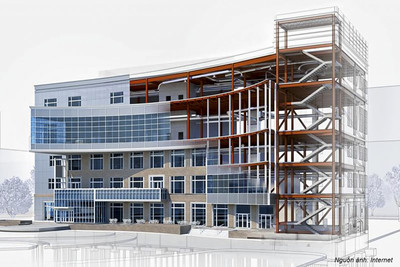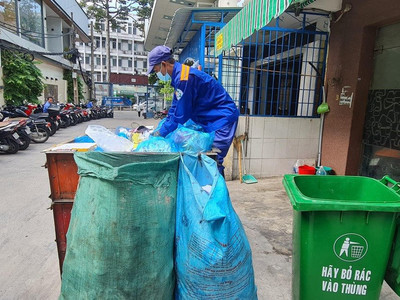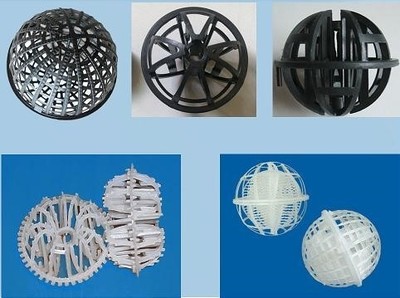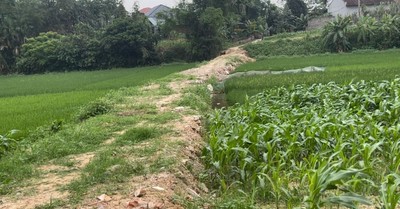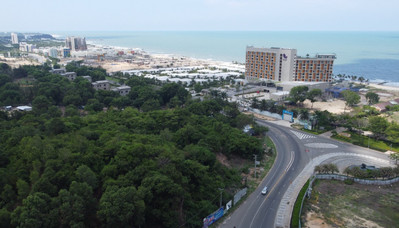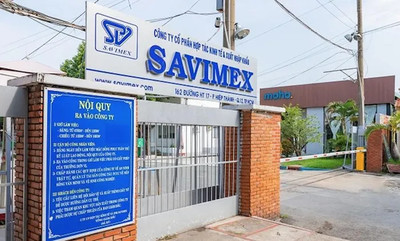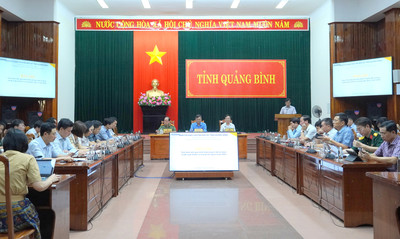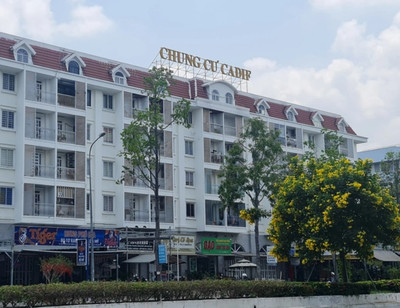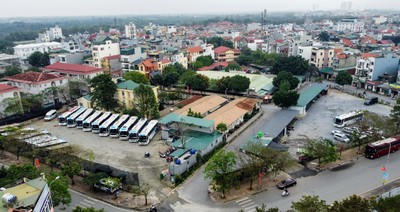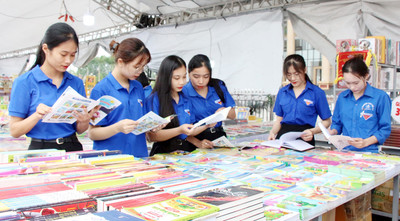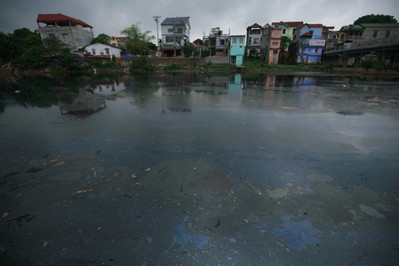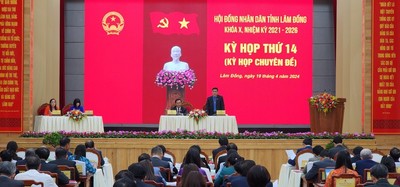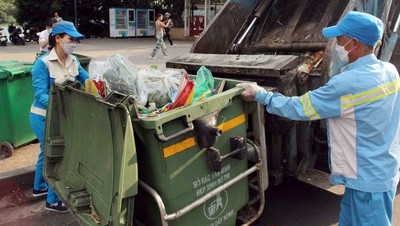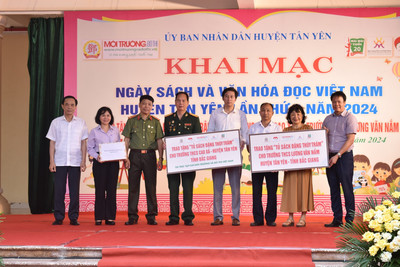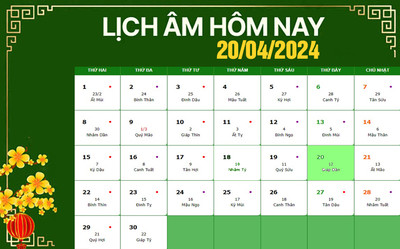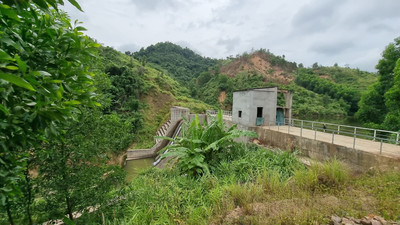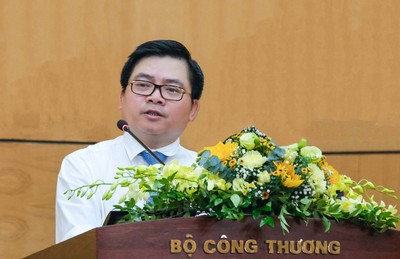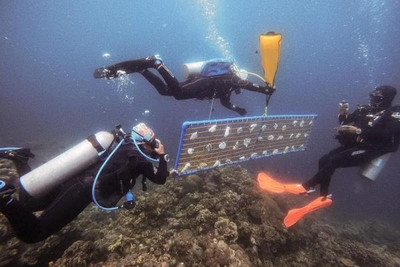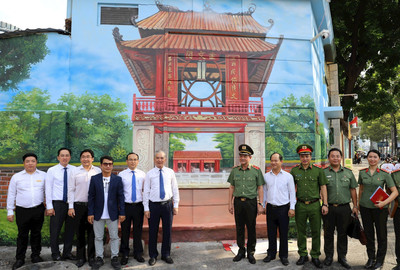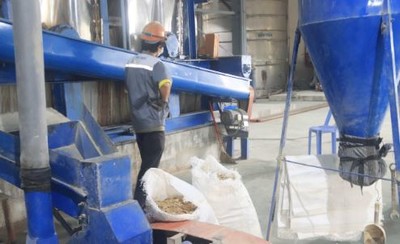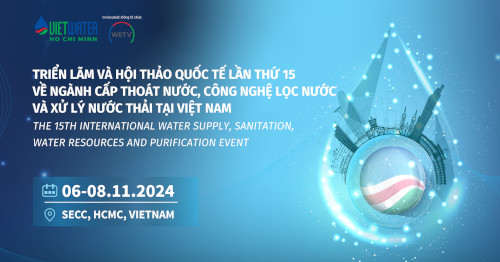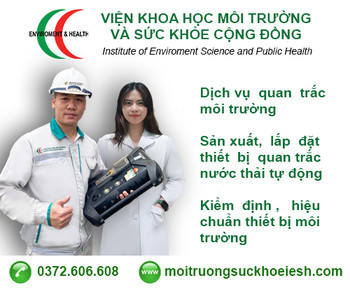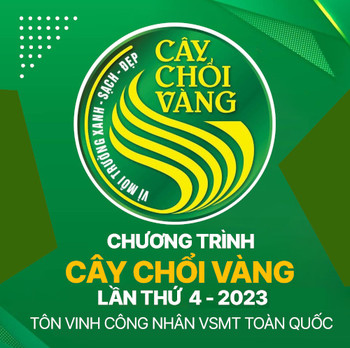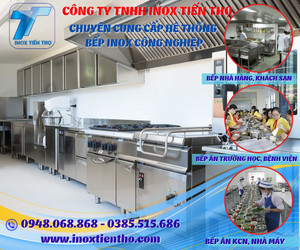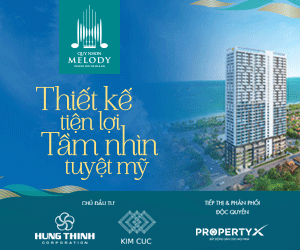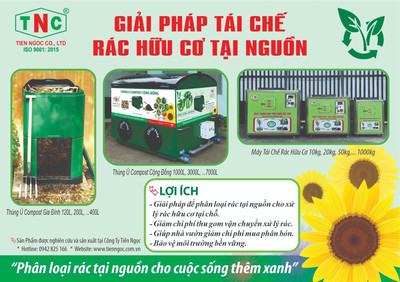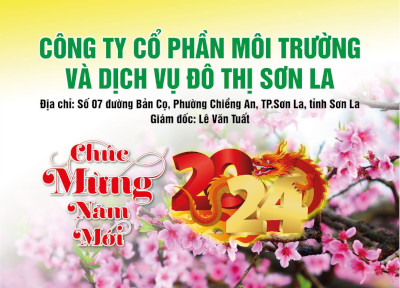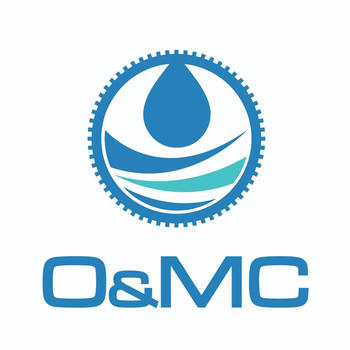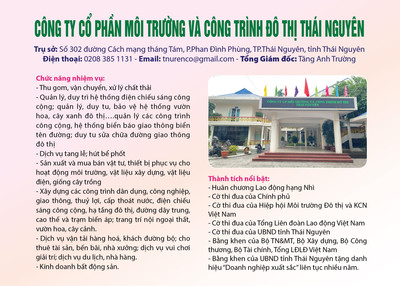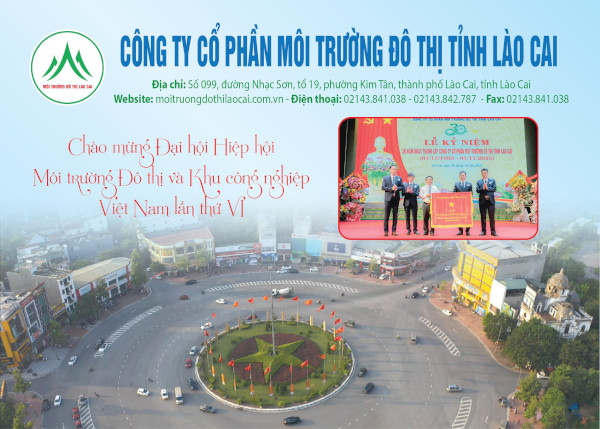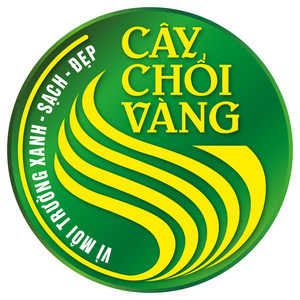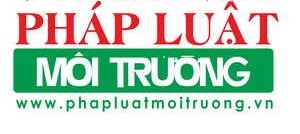Công bố quốc tế trong lĩnh vực kiến trúc, xây dựng, đô thị (Kỳ 4)
Xin giới thiệu tới quý độc giả những nội dung chính của các công bố quốc tế đăng tải trên ScienceDirect và Springer Nature do Cục Thông tin khoa học và công nghệ quốc gia (NASATI) mua quyền truy cập
Trong số này chúng tôi xin giới thiệu tới quý độc giả những nội dung chính của các công bố quốc tế đăng tải trên ScienceDirect và Springer Nature do Cục Thông tin khoa học và công nghệ quốc gia (NASATI) mua quyền truy cập như sau:
Quy hoạch đô thị:
– Các đề xuất giá trị khác nhau trong danh mục hoạt động của 9 thành phố thông minh
– Thay đổi về định cư sau khi dân số đạt mức cao nhất: Dự báo hệ thống đất đai cho Trung Quốc đến năm 2050
– Cung cấp các dịch vụ sinh thái, văn hóa và thương mại trong một công viên đô thị
– Những mảng thực vật nhỏ làm giảm đáng kể nhiệt độ bề mặt đô thị trong đợt nắng nóng mùa hè ở Adelaide, Australia
– Định lượng tác động làm mát cục bộ của không gian xanh đô thị: Bằng chứng từ Bengaluru, Ấn Độ
Khoa học và công nghệ trong lĩnh vực xây dựng:
– Tối ưu hóa đa mục tiêu về hiệu suất năng lượng của tòa nhà bằng cách kết hợp mạng nơ-ron nhân tạo và các thuật toán metaheuristic
– Sử dụng máy học để kiểm tra các loại không gian xanh đường phố ở độ phân giải không gian cao
Vật liệu xây dựng:
– Đặc điểm truyền nhiệt của tấm tổ ong bằng giấy lõi rơm
– Ảnh hưởng của polyme viscoelastic đến tính chất giảm chấn của tấm bê tông đúc sẵn
– Hệ thống kết nối di động composite sinh học in 3D cho các cấu trúc không gian bằng tre
– Cải thiện tính bền vững của sản xuất gạch men ở Thổ Nhĩ Kỳ
– Định lượng hành vi hút nước bất thường của vữa xi măng dựa trên độ nhạy vật lý với nước
– Mô hình thiết kế thân thiện môi trường và tối ưu về kinh tế (EEODM) để giảm lượng khí thải CO2 và chi phí của tấm waffle slabs
Xin trân trọng giới thiệu!
QUY HOẠCH ĐÔ THỊ
1. The many faces of the smart city: Differing value propositions in the activity portfolios of nine cities
Cities, Volume 112, May 2021, 103116
Abstract:
There are still misunderstandings and differing opinions about what a smart city (SC) is, and there are only of few publications available on what beneficial outcomes cities are anticipating from SC developments. This paper identifies nine anticipated benefits/value proposition components of smart city activities, based on a literature review. It then uses a comparative multiple case study analysis to investigate how value proposition components are present in the SC activities of six cities with demonstrated excellence: Amsterdam, Barcelona, London, Helsinki, New York, Vienna; and three with emerging excellence: Berlin, Budapest, Moscow. The study reveals the distribution of the components in each city for different years, then these annual activity portfolios are clustered. Four different types of smart cities emerge from the analysis: (1) The Green City – in which years of activities, cities are focusing on environmentally related objectives; (2) The App City – in which years of activities, cities are focusing on developing and rolling out platforms and ICT applications to provide Quality of Life improvements directly for citizens; (3) The Socially Sensitive City – in which years of activities socially sensitive activities are prominent; (4) The Participatory City – in which years of activities citizen engagement is in focus. The findings provide a more comprehensive explanation to the mono-dimensional and holistic strategic approach of smart cities.
2. Settlement changes after peak population: Land system projections for China until 2050
Landscape and Urban Planning, Volume 209, May 2021, 104045
Abstract:
China has experienced unprecedented urbanization in the past few decades, fueled by population growth, economic development, and rural to urban migration. In the future, economic growth as well as rural to urban migration is expected to continue, but demographic scenarios indicate that the population of China will peak and subsequently decline. As a result, it is unsure how urban areas will develop after peak population. In this study we further develop the CLUMondo land system model to simulate land system changes in China until 2050. Our application represents a range of settlement systems, from dense urban areas to village landscapes, differing in their built-up area as well as their population density to enable the simulation of different settlement change trajectories. Our results show that a UN high population scenario in combination with a continued decline in population density leads to an increase of built-up land of about 48%. Conversely, the UN low population scenario in combination with a constant population density could be accommodated within the current amount of built-up land in China. Due to prevailing cropland protection policies, increase in built-up land will mostly lead to a loss of natural areas, hence our scenarios highlight the opportunity space for limiting land take and saving natural areas. This study also demonstrates the need for more nuanced representation of settlement systems for the assessment of land change trajectories.
3. Providing ecological, cultural and commercial services in an urban park: A travel cost–contingent behavior application in Finland
Landscape and Urban Planning, Volume 209, May 2021, 104042
Abstract:
The need for monetary valuation of recreational ecosystem services in urban areas is greatly acknowledged in several contexts. Most often, studies provide a total value of recreational visits, but a separate contribution of ecosystem, cultural, and commercial services to the value of recreation in urban ecosystems is rarely provided. In this study, the recreational importance of an urban park including streams is assessed, and the welfare implications of planned future improvements in three types of service are revealed, i.e. the restoration of the reproductive brown trout population, an increased number of happenings or events, and the service of a cafeteria-restaurant. Travel cost and contingent behavior methods are combined, which has not previously been applied in such a context. The results show that people perceive the park’s importance for their well-being. The improvements of each service separately tended to increase the value between 14% and 21%, and of all services simultaneously by 66%. Remarkably, individuals with low incomes valued the park more than wealthier individuals. As the park is a free access environment, this suggests that the improvement of its recreational possibilities may especially benefit those with fewer opportunities for chargeable free time activities. Respondents’ awareness of the reconstruction and management project of the park and the streams tended to increase the number of visits to and value of the park. At the societal level, the stream restoration was found to be highly profitable.
4. Small vegetated patches greatly reduce urban surface temperature during a summer heatwave in Adelaide, Australia
Landscape and Urban Planning, Volume 209, May 2021, 104046
Abstract:
As the global climate warms, cities worldwide face more frequent and extreme heatwaves. These events can affect human health and decrease liveability. While the mitigating effects of vegetation on land surface temperature (LST) are well characterised at large spatial scales and during typical weather conditions, the cooling benefits that urban greening can provide at local scales, particularly during summer heatwaves, are poorly quantified.
We quantified LST variation across an urban landscape to assess relationships with land use and vegetation cover from land unit (average ~ 460 m2) to suburb scale (~1.66 km2) under extreme summer heat conditions. High resolution (2 m), day- and night-time LST was measured at the peak of a heatwave event, after three consecutive days with air temperature exceeding 40 ˚C, by flying an aircraft fitted with a thermal imager over 90 suburbs in Adelaide, Australia. Daytime, night-time, and diurnal range LST distributions were related to measures of land use, vegetation cover (i.e., tree, grass) and urban morphology at both the suburb and land unit scale.
At the suburb scale, vegetation cover did not affect LST. However, at the land unit scale, tree canopy cover, and to a lesser extent grass cover, decreased local LST by up to 6 ˚C during the day, but not at night. Overall night-time LST was poorly predicted by the land use and land cover predictors. Moving inland from the coast, small vegetation patches, mostly contained in yards and gardens, was associated with the greatest localised LST reductions in the hotter inland suburbs. LST within land units was further decreased during the day when vegetation was present within 30 m buffers around each land unit, suggesting a moderate landscape cooling effect on LST.
Our results suggest that even small urban vegetation patches can be managed to provide substantial heat mitigation during increasingly frequent summer heatwaves, particularly around the residential environments where people live.
5. Does rated visual landscape quality match visual features? An analysis for renewable energy landscapes
Landscape and Urban Planning, Volume 209, May 2021, 104000
Abstract:
Finding the “right” sites for developing renewable energy systems (RES) is one of the major challenges in planning strategies for energy transitions. The visibility aspects of such infrastructure are important factors that explain local opposition. Classical visibility and viewshed analyses of RES disregard people’s perceptions and estimations of new infrastructure. To address this void, we demonstrate an approach that combines rated visual landscape qualities with measured visual features. In doing so, we established visual stimuli with systematically controlled visual impact scenarios featuring the use of renewables in different landscape types. The study investigated how ratings of landscape qualities are affected by landscape changes stemming from RES. We also identified measurable visual features that might help to operationalize landscape qualities. Finally, we intended to improve the understand of how rated landscape qualities lead to preferences for different RES visual impact scenarios. Our results showed that rated coherence is strongly influenced by renewable energy infrastructure, whereas complexity ratings are affected mainly by variations in landscape types. These findings let us to conclude that the visual understanding and visual connectedness between energy systems and surrounding landscapes are core drivers of people’s visual preferences for landscapes altered with RES. Considering landscape qualities within impact assessments of RES can augment our grasp of how the visual character of a landscape changes through renewable energy infrastructure.
6. Quantifying the local cooling effects of urban green spaces: Evidence from Bengaluru, India
Landscape and Urban Planning, Volume 209, May 2021, 104043
Abstract:
Rapid unplanned urbanization has led to a deterioration in green cover in Indian cities and an increase in urban temperatures due to the urban heat island (UHI) effect. With India’s urban population set to double from 400 million in 2011 to 800 million by 2050, it becomes critical to understand the role of urban green spaces (UGS) in mitigating the UHI. In this study, we have used high-resolution Landsat and Google Earth data and integrated it with spatial statistical analysis to quantify the cooling effects provided by UGS beyond their boundaries. We analyzed cooling effects at the level of individual UGS for 262 UGS in the megacity of Bengaluru, India. Our results showed that the average UGS provided local cooling effects till points 347 m (95% CI: 318 m to 376 m) beyond its boundary. The average UGS was 2.23 °C (95% CI: 2.13 °C to 2.33 °C) cooler than the point where it ceased to provide cooling effects. Cooling effects reduced with distance from the UGS, and were impacted by the greenness, size, and shape of the UGS. The findings of this study are important in the context of India’s Smart Cities Mission that has been criticized for an inadequate focus on urban greening. Our study addresses a concern that most previous studies have used a small sample of UGS for their analysis. To the best of our knowledge, this is the first study to quantify the role of UGS in localized surface temperature reduction for a large Indian city.
7. Environmental design guidelines for residential NZEBs with liner tray construction
Journal of Building Engineering, Available online 7 May 2021, 102580
Abstract:
Liner tray, steel gauge, or cassette construction is a lightweight steel frame system (LSF) especially suited for low-rise buildings, which offers celerity and quality. It is a viable option for constructing affordable residential Nearly Zero Energy Buildings (NZEBs) in those areas where ‘craft-based’ house-building industries have proven unsustainable, as occurs in some countries of Southern Europe. From an environmental point of view, the continuous disposition of liner trays allows excellent adaptability to the microclimatic context and the particularities of the local site as well as the thermal homogeneity of the envelope. However, its lightweight can entail large thermal variations and overheating problems, especially in constructions with high thermal resistance. A careful design adapted to each location can help avoid these problems, but accurate energy calculations are not always feasible in detached house design. This paper studies the Proyectopía system’s passive strategies, an innovative liner tray system made of extruded aluminum for sustainable, low-cost detached houses in Spain. Environmental design guidelines can be a powerful and suitable tool for addressing various house projects that share the same construction system. Several parameters with a substantial impact on the house energy demand, such as insulation thickness, window glazing type, window-to-wall ratio, solar shading, and thermal inertia, are analyzed in a house prototype. Designers can use these parametric study results to perform environmental assessments from the early stages of the design process.
8. A hover view over effectual approaches on pandemic management for sustainable cities – The endowment of prospective technologies with revitalization strategies
Sustainable Cities and Society, Volume 68, May 2021, 102789
Abstract:
The COVID-19 pandemic affects all of society and hinders day-to-day activities from a straightforward perspective. The pandemic has an influential impact on almost everything and the characteristics of the pandemic remain unclear. This ultimately leads to ineffective strategic planning to manage the pandemic. This study aims to elucidate the typical pandemic characteristics in line with various temporal phases and its associated measures that proved effective in controlling the pandemic. Besides, an insight into diverse country’s approaches towards pandemic and their consequences is provided in brief. Understanding the role of technologies in supporting humanity gives new perspectives to effectively manage the pandemic. Such role of technologies is expressed from the viewpoint of seamless connectivity, rapid communication, mobility, technological influence in healthcare, digitalization influence, surveillance and security, Artificial Intelligence (AI), and Internet of Things (IoT). Furthermore, some insightful scenarios are framed where the full-fledged implementation of technologies is assumed, and the reflected pandemic impacts in such scenarios are analyzed. The framed scenarios revolve around the digitalized energy sector, an enhanced supply chain system with effective customer-retailer relationships to support the city during the pandemic scenario, and an advanced tracking system for containing virus spread. The study is further extended to frame revitalization strategies to highlight the expertise where significant attention needs to be provided in the post-pandemic period as well as to nurture sustainable development. Finally, the current pandemic scenario is analyzed in terms of occurred changes and is mapped into SWOT factors. Using Fuzzy Technique for Order of Preference by Similarity to Ideal Solution based Multi-Criteria Decision Analysis, these SWOT factors are analyzed to determine where prioritized efforts are needed to focus so as to traverse towards sustainable cities. The results indicate that the enhanced crisis management ability and situational need to restructure the economic model emerges to be the most-significant SWOT factor that can ultimately support humanity for making the cities sustainable.
9. Exciting walk-only precincts in Asia, Europe and North-America
Cities, Volume 112, May 2021, 103129
Abstract:
Walkable places are valuable assets in cities. They have advantages over vehicle-oriented spaces in terms of economic, social, health, energy and environmental perspectives. Walk-only precincts (WoP) have been built in various parts of the world with different degrees of success. City size, and all the urbanization and planning implications that it brings, is not the main determinant to build WoP, as these can be found in large as well as small and medium size cities in Asia, Europe and the Americas. However, small and medium size cities are increasingly burdened by the appearance of new commercial centers elsewhere, a lack of funding for urban design and programmatic improvements, and limited spirit of initiative by current precincts’ stakeholders. Using the Commercial Revitalization Vibrancy (CRV) theory, this paper compares and contrasts WoP in three pair-wise large and small cities: Shanghai (China) and Macau (SAR of PRC), Lisbon and Figueira da Foz (Portugal), and New York City and Miami Beach in the United States. Field work was conducted in all cities during the last decade and a half. Three conclusions and key findings for the success of this type of precincts are distilled.
10. Urban function classification at road segment level using taxi trajectory data: A graph convolutional neural network approach
Computers, Environment and Urban Systems, Volume 87, May 2021, 101619
Abstract:
Extracting hidden information from human mobility patterns is one of the long-standing challenges of urban studies. In addition, exploring the relationship between urban functional structure and traffic spatial interaction pattern has long been of interest. Recently, vehicle GPS trajectory data emerged as a popular data source for revealing human mobility patterns and urban functions. However, few studies have fully leveraged traffic interaction information that is hidden in human mobility patterns to identify urban functions at the road segment level. To address this issue, a geo-semantic analysis framework was introduced in this study to model the relationship between traffic interaction and urban functions at the road segment level. First, a Road-Trajectory corpus was built and trained to obtain the semantic embedding representation of road segments. Then, considering topological connections between road segments, we used a graph convolutional neural network model to process the contextual and topological information to classify social functions along streets. A case study in Beijing, China, using a large volume of real-world taxi trajectories data, was conducted. The results show that our proposed methods, with relative less loss and high accuracy, outperform other comparative methods for classifying urban functions at the road segment level. This work contributes to the assessment of urban functional structure, and further aiding urban planners in designing better urbanization strategies with regard to traffic interaction and urban space structure.
11. Tree layout methodology for shading pedestrian zones: thermal comfort study in bilbao (northern iberian peninsula)
Sustainable Cities and Society, Available online 7 May 2021, 102996
ABSTRACT:
The need to reduce heat-related thermal stress calls for a reassessment of shading in outdoor urban spaces with the aim of achieving more habitable and sustainable cities. In this research, a methodology based on mathematical formulas is presented and applied to determine the most appropriate geometric properties and position of the trees to be planted in an urban canyon, based on its E-W solar orientation and the height of the buildings. The methodology relies on shading the largest possible surface area of the pedestrian zones of a canyon through the appropriate autochthonous tree species, but it also requires a thermal-comfort evaluation of tree transmissivity. The case study is validated in Bilbao, where a combination of measurement and modelling techniques (Solweig model) are used to verify suitable guidelines for urban design. The results will be of interest to architects and city planners for decision-making when integrating trees, so that urban thoroughfare development can improve thermal comfort in actual or new canyons. The methodology could be applied to other climatic regions, although some of the parameters used both for the evaluation of the heat-related critical moments and in the formulas should be adapted.
12. Future urban expansion and local climate zone changes in relation to land surface temperature: Case of Bangkok Metropolitan Administration, Thailand
Urban Climate, Volume 37, May 2021, 100835
Abstract:
This paper focuses on land use and land cover (LULC) expansion and local climate zone (LCZ) changes in relation to warming in the future, the study concentrates on three major parts. First, this research analyzes LULC and LCZ changes from 1991 to 2016 using Landsat satellite images data. This reveals the history of urban expansion over the study period, urban growth rate and urban land demand projection in the target year (2026). Second, the study determines LULC and LCZ changes in the future by using spatial logistic regression model. Third, the examination of urban expansion in relation to warming in the future was conducted. The result shows that the built-up area has more development and expansion to the northern, southern and western parts of Bangkok. The built-up surface temperature climbed and continued to increase between 1991 and 2016. The trend of temperature differences between the built-up areas and other areas, significantly widened in 2026. Most of green area on the western part of Bangkok was replaced by compact mid-rise, compact low-rise, and open low-rise building. The study means that the western part of the city will be warmer approximately 1 to 2 °C in the future.
13. An efficient dynamic route optimization for urban flooding evacuation based on Cellular Automata
Computers, Environment and Urban Systems, Volume 87, May 2021, 101622
Abstract:
Flooding has been one of the major issues that have seriously hampered the developments of the urban systems, as well as threatened the urban water environments. To mitigate the impacts of floods, it is highly important to identify effective evacuation plans with the aid of computer-based methods. However, effectively identifying the dynamic evacuation route based on the evolution of flooding status is difficult and challenging. To this end, this study develops a Cellular Automata-based Dynamic Route Optimization (CADRO) algorithm to identify the dynamic flood evacuation route (FER), where the hydrodynamics, topography and human response time are incorporated. The proposed CADRO is applied in a suburb of Yangzhou City, China, and results demonstrate the people trapped rate, the mean and maximum length of FERs are shortened by nearly 32.70%, 34.04% and 7.90%, respectively compared with the traditional A* algorithm used for evacuation route optimization. One important feature of the proposed CADRO is that it can identify the dynamical variation of terrain connectivity within the flooding process, thereby offering the optimal FERs. In addition, the impacts of the human response time to the FERs are investigated in this study. It is anticipated that the proposed CADRO can be greatly beneficial to the urban flooding risk management.
14. Environmental justice and surface temperature: Income, ethnic, gender, and age inequalities
Sustainable Cities and Society, Volume 68, May 2021, 102810
Abstract:
Severe land surface temperature (LST) significantly impacts residents’ thermal discomfort and can be life-threatening during warm seasons. Therefore, it is essential to identify the inequalities in LST exposure, i.e. the socioeconomic groups who are over- or underexposed to LST. There is a knowledge gap in the literature: there is no previous study which differentiates between national-scale inequalities -i.e. inequalities apparent in all location of a country, and the local-scale inequalities -i.e. inequalities existing in some areas of a country. Employing a semi-parametric geographically weighted regression model to study LST in Dutch residential zones in the summer of 2014, the results of this study show that two national-scale inequalities are significant: overexposure of high-income groups and underexposure of the owners of high-value properties. Additionally, eight local-scale inequalities are identified. Among the latter, ethnic inequalities, overexposure of Non-western and Western immigrants, found to be the most severe and frequent at the local scale. Additionally, females are often the second most overexposed to LST at the local-scale. To a lesser degree Rental dwellings and Population age 15−24 are the second most overexposed of a zone’s population. In the end, the results and policy implications are discussed.
15. Istanbul: The city as an urban palimpsest
Cities, Volume 112, May 2021, 103131
Abstract:
The metropolitan cities of the world continue to grow rapidly with their dynamic, mostly chaotic features that perpetually contain randomness, notwithstanding their specific differences. These inevitably constantly changing and transforming cities are shaped together with their permanent inhabitants and produce new urban spaces. In this regard, Istanbul has always been a laboratory for architectural applications, research and education rightfully due the numerous potentials it embodies. In this context, informal trainings and activities carried out outside the programs in architectural schools are increasingly becoming more important, and Istanbul is used as an instrument for these studies. From this point of view, so as to contribute to the discussions on the palimpsest character of Istanbul and to provoke post-graduate students and young architects to question the multi-layered state of the city, ‘Culture and Space’ Network has been organizing paper selections in Turkey for eight years. This current article reviews and analyzes a selected group of awarded papers from the paper selections in order to explore the concept of ‘urban palimpsest’, to read and understand the multi-layered and palimpsest structure of Istanbul from their perspectives, and to highlight their interpretations.
16. Self-sufficiency through urban agriculture: Nice idea or plausible reality?
Sustainable Cities and Society, Volume 68, May 2021, 102770
Abstract:
With more than half of the world’s population residing in cities, there has been intense interest in urban agriculture’s contribution to sustainability and self-sufficiency. This paper provides new insights into the potential for food production to occur within residential properties. High-resolution optical imagery was employed to quantify residential land immediately available for vegetable production (i.e. residential lawn) in a low-density city. Adelaide (Australia) was used as a case study. Productivity was estimated according to three empirical (low, medium and high) and one commercial yield scenario. Under high and medium yield scenarios, lawn in a typical block exceeded the space required to achieve household self-sufficiency of vegetables. Under the high-yield scenario, 23 % of lawn area would be required to meet the recommended vegetable intake of residents, while under the medium yield scenario, 72 % would be required. This study demonstrates the plausible reality of self-sufficiency through backyard vegetable production. Other resources that might limit production, such as labour, water and nutrients, are explored in the discussion. Urban agriculture is shown to be particularly worthwhile in low density cities; contrasting previous research performed under different urban conditions. However, in this case study, potentially productive land has decreased over time.
17. A MILP optimization method for energy renovation of residential urban areas: Towards Zero Energy Districts
Sustainable Cities and Society, Volume 68, May 2021, 102787
Abstract:
The nearly Zero Energy Building concept should be adopted in the renovation of existing buildings and actions upscaled and applied to larger and larger urban areas. In this context, this paper presents an optimization methodology for drafting integral renovation actions at district level. The methodology is based on a MILP model that allows selecting energy saving measures, as well as the design and operation of energy supply systems amongst a very large set of potential permutations. For its application, the concept of District Equivalent Building is introduced, defined as a virtual building with a set of energy loads equal to the addition of all the individual load vectors of each building.
The methodology was applied to a real residential district located in Bilbao (northern Spain). For this case study, the optimal renovation plan was obtained, considering for that three different optimization objectives: (i) Optimal-Cost, (ii) Zero Energy District (ZED) and (iii) Zero Energy District including domestic electricity consumption in the calculation of the non-renewable primary energy consumption (ZED’). Although similar solutions were adopted for each of these cases, significant differences were get attending the hourly operation of the solutions. These cases were economically assessed and the optimal-cost curve was obtained.
18. Evaluation and application of a low-cost measurement network to study intra-urban temperature differences during summer 2018 in Bern, Switzerland
Urban Climate, Volume 37, May 2021, 100817
Abstract:
The understanding of intra-urban air temperature variations is crucial to assess strategies for cities’ adaptation to impacts of present and future anthropogenic climate change. Depending on extensive measurement networks, high-resolution air temperature measurements in urban environments are challenging due to high instrumentation and maintenance costs. Here, we present a low-cost measurement device (LCD) consisting of a temperature logger and a custom-made, naturally ventilated radiation shield. Besides intercomparisons with automated weather stations (AWS) at three reference sites during record-dry summer 2018, we tested the potential of the devices using a network of 79 LCDs to assess the intra-urban variability of urban heat island (UHI) patterns in the city of Bern, Switzerland. We found positive mean measurement biases between LCDs and AWS of 0.61 to 0.93 K (RMSE: 0.78 to 1.17 K) during daytime, of which up to 82.8% of the variance could be explained statistically by solar irradiance (radiative heating) and wind speed (insufficient ventilation). During night, average measurement biases were markedly lower and eventually negative with −0.12 to 0.23 K (RMSE: 0.19 to 0.34 K). Our results highlight the importance of sensor intercomparisons being conducted at multiple locations with differing urban land-cover, structure, and metabolism given that biases varied considerably between the reference sites. Data retrieved by the city-wide measurement network showed that the LCD approach is well suited for the analysis of spatiotemporal UHI patterns during night and adds considerable value compared to the few existing AWS in detecting fine-scale air temperature variability. In conclusion, the current LCD measurement approach represents a valuable option for cost-effective analyses of urban air temperature variability across multiple scales, which may be of particular value for the development, appliance, and monitoring of adaptation strategies to climate change in cities with restricted financial resources.
19. Can autonomous vehicles enable sustainable mobility in future cities? Insights and policy challenges from user preferences over different urban transport options
Cities, Volume 112, May 2021, 103134
Abstract:
Creating sustainable urban futures partly requires reducing car-use and transport induced stresses on the environment and society. New transport technologies such as autonomous vehicles are increasingly assuming prominence in debates about the transition toward sustainable urban futures. Yet, enormous uncertainties currently exist on how autonomous vehicles might shape urban mobility. To address this gap, this paper examines the latent behavioural and socio-demographic factors that will drive the adoption of and preferences for different use options of autonomous vehicles, utilizing survey data from Dublin, Republic of Ireland. Based on this, it explores how autonomous vehicles might shape travel behaviors through mode choice and the potential sustainability implications. The findings show that regarding preferences for a specific alternative (i.e. sharing, ownership and public transport), attitudes toward these use options matter the most, rather than overall perceived benefits of autonomous vehicles. Moreover, for single mode options, shared-autonomous vehicles remain the least popular, while preference for ownership of autonomous vehicles, either as a single option or in combination with sharing and public transport, is high. Across the different autonomous vehicles options, there is high preference for clean engine fuel sources (i.e. electric and hybrid). Given the embeddedness of preferences for autonomous vehicles in attitudes and choices regarding existing forms of motorized transport, it is possible that the current modal split and the large share of private car-based transport, might not change in the era of autonomous mobility. However, urban transport policy can leverage the overall positive attitudes toward the environment, sharing and public transit to nudge choices toward achieving the normative goals of sustainable urban transport.
20. Perceived benefits from agroforestry landscapes across North-Eastern Europe: What matters and for whom?
Landscape and Urban Planning, Volume 209, May 2021, 104044
Abstract:
Agroforestry landscapes are crucial to human wellbeing; however, they are in sharp decline across Europe. Improved understanding of the complexity of agroforestry landscapes within different biophysical, social-cultural, economic and governance contexts is essential for designing effective policy and management interventions that are more tightly aligned with societal expectations and aspirations. This paper identifies and compares values that people attribute to agroforestry landscapes across North-Eastern Europe, using case studies in Sweden, Latvia, Belarus, and the Russian Federation. We apply the multiple-value approach developed for the conceptual framework of the Intergovernmental Platform on Biodiversity and Ecosystem Services to an assessment of agroforestry landscapes. Using data from a total of 1634 face-to-face structured interviews, we (i) analyse and explore the preferences of diverse groups of respondents for agroforestry landscapes; (ii) identify a broad range of nature’s contributions to people (NCP) that were attributed to agroforestry landscapes by respondents; and, (iii) analyse values of agroforestry landscapes across different contexts in NorthEastern Europe. We found that a highly heterogenous group of people – broadly irrespective of age, education, gender, place of residence, as well as political, economic, or social-cultural context – perceive agroforestry landscapes to be important to their quality of life. Respondents attributed multiple NCP to agroforestry landscapes, and non-material NCP are the most frequently assigned in all four countries. An absolute majority of respondents across all case studies considered relational values of agroforestry landscapes to be important for their quality of life with identity as the most often associated with agroforestry landscapes.
KHOA HỌC VÀ CÔNG NGHỆ TRONG LĨNH VỰC XÂY DỰNG
1. BIM-based information system for econo-enviro-friendly end-of-life disposal of construction and demolition waste
Automation in Construction, Volume 125, May 2021, 103611
Abstract:
Increasing quantities of Construction and Demolition Waste (CDW) have caused serious resource shortages and environmental damage, resulting in the requirements of scientific disposal technologies and methods. In this study, based on the 3R principle, a Building Information Modeling (BIM)-based CDW information system is established using Revit software to reduce the CDW, which overcomes the obstacles of BIM adoption and displays information directly related to CDW. A Reverse Logistics (RL) network is then proposed to regulate the end-of-life disposal of CDW, after which mathematical formulas are introduced to calculate the disposal costs and carbon emissions, to achieve environmental and economic balance. The results showed that the methodology was successfully applied, with precise CDW information obtained for the disposal cost and emission estimations, and high recovery of CDW was guaranteed to achieve sustainable waste development. Efforts can be made on CDW 3D visualization interfaces and the social benefits consideration in future research.
2. Virtual dynamic coupling of computational fluid dynamics-building energy simulation-artificial intelligence: Case study of urban neighbourhood effect on buildings’ energy demand
Building and Environment, Volume 195, 15 May 2021, 107728
Abstract:
Coupling of building energy simulation (BES) tools with computational fluid dynamics (CFD) technique offers the ability to include the commonly neglected, but significantly important, neighbourhood effect on the local airflow patterns and thus buildings’ energy demand. Amongst various coupling approaches, the fully dynamic coupling is considered as the most accurate technique although not a practical one for medium-to-long-term simulations due to the associated high computational cost.
This study, therefore, aims to propose a novel framework of virtual dynamic BES-CFD-artificial intelligence (AI) coupling to prevent intensive computational calculations. The prediction is performed by artificial neural network (ANN), which is trained over a series of fully dynamic BES-CFD coupling results to replace the local flow characteristics, in particular, convective heat transfer coefficient (CHTC). Furthermore, a case study of a city block performed in a typical hot month (September) in Los Angeles is undertaken to assess the proposed framework.
The predictions of the local CHTCs on the external surfaces are found satisfactory with an accuracy of 0.88. Moreover, 10 is found as the effective size of days to train the neural network tools for a one-month simulation. The proposed approach results in saving approximately 2/3 of the required computational time using an ordinary approach.
3. Multi-objective optimization of building energy performance and indoor thermal comfort by combining artificial neural networks and metaheuristic algorithms
Energy and Buildings, Volume 239, 15 May 2021, 110839
Abstract:
During the last few years, multi-objective optimization processes have become one of the main challenges for energy efficiency in buildings. In this work, a new efficient multi-objective optimization method, based on the Building Performance Optimization (BPO) technique, has been developed to improve the indoor thermal comfort and energy performance of residential buildings, i.e. a Moroccan ground floor + first floor (GFFF) house located in Marrakech region (5th climatic zone according to the Thermal Building Code in Morocco). The most influential design variables have been well explored in order to find the optimal trade-off between these two objectives. Indeed, this technique is based on the integration of Artificial Neural Networks (ANNs), in particular Multilayer Feedforward Neural Networks (MFNN), coupled with the most commonly used metaheuristic algorithms, i.e. Non-dominated Sorting Genetic Algorithm (NSGA-II), Multi-Objective Particle Swarm Optimization (MOPSO) and Multi-Objective Genetic Algorithm (MOGA), in order to minimize computation time as much as possible. The TRNSYS software was used to establish the various dynamic thermal simulations required to create the database, from which the ANNs were able to set up their learning. The results show that this methodology is being used successfully, leading to different proposed solutions in terms of building envelope design. However, only the solutions using MOPSO are finally retained, as they have shown the greatest desired performance compared to the others. Thus, the thermal needs, particularly those for heating and cooling, have been significantly reduced to 74.52% of the total, while improving the indoor thermal comfort by 4.32% compared to the base design. Finally, we strongly recommend this methodology to the different actors in this field, including designers, engineers, architects, engineering offices, etc., when several objectives need to be contrasted while simultaneously considering several design variables.
4. Thermal comfort standards in the Middle East: Current and future challenges
Building and Environment, Available online 4 May 2021, 107899
Abstract:
Cooling energy demand has increased three-fold in the Middle East (ME) over the last 30-years. This is driven by the need to maintain thermal comfort in an extremely hot climate, and supported by rising incomes, falling costs of air-conditioning and growth in the number of buildings. The definition of thermal comfort in these buildings is drawn from “international” standards, which, though empirically derived, have no basis data from this region. Hence, we ask, to what extent do indoor conditions in the ME fall within the standards recommended range of thermal comfort, and when they do, whether they are found to be comfortable by their occupants. We present the first large-scale study of thermal comfort in the ME, consisting of two approaches: (i) a meta-analysis of data from existing studies, (ii) independent field data covering four countries representing 27% of the region’s population, 31 air-conditioned buildings of different types, including “green” buildings, and 1,101 subjects. The meta-analysis demonstrates that current thermal comfort standards fail to predict thermal sensation of 94% of occupants. Our own data show that, while indoor conditions are within standards-recommended ranges 58% of the time, only 40% of occupants find these conditions acceptable. We find evidence of overcooling in summers, with 39% occupants expressing cold discomfort. Computer models suggest that this is likely to have increased annual cooling energy demand between 13%-20%, compared to non-overcooled conditions. These results suggest the necessity of localised thermal comfort standards that mitigate excess cooling energy demand, without compromising occupant thermal comfort.
5. Radiation noise control of a 90° rectangular elbow in ventilation and air conditioning systems
Journal of Building Engineering, Volume 37, May 2021, 102157
Abstract:
The elbow noise is an important part of indoor radiated noise of ventilation and air conditioning (VAC) systems. A technique to reduce the radiated noise of the elbow by adding guide vane is proposed. The models of elbow with/without guide vane were established respectively. Based on the experimental verification, the influence of the guide vane on the flow field of the elbow and the indoor radiated sound field is analyzed. The radiated noise of the elbow was predicted by LES simulation and FW-H equation. The results show that after adding the guide vane, the maximum resistance loss of the elbow can be reduced by about 17%, and the radiation noise can also be significantly reduced in the frequency range of 10–1000 Hz. However, the local turbulent dissipation slightly increases in the elbow due to the guide vane, causing an increase in the peak sound pressure level in the low frequency range of 10–200 Hz. In addition, in the proper position of the guide vane, the influence of elbow radiated noise on standing, sitting and lying posture is also significantly reduced. The maximum radiated total sound pressure level at the design point is reduced by about 5 dB.
6. Effectiveness of waste plastic bottles as construction material in Rohingya displacement camps
Cleaner Engineering and Technology, Available online 18 May 2021, 100110
Abstract:
Bangladesh is currently hosting about 1.30 million Rohingya people in its southeastern region, the most persecuted ethnic minority of the world. The present semi structured living shelters mostly made of bamboo and plastic sheets, are not resistant to environmental disasters like- monsoon rain, cyclone, mudslide, and prone to cause vector borne diseases. This study developed plastic brick, where a waste 500 mL polyethylene terephthalate bottle was utilized which was manually compacted with air dried fine sand as the filler material. Cardboard frame was used to shape the brick like a normal clay brick. The filled bottle was placed at the central portion of the frame where hand blended mortar was used to cover the whole frame up to the marked dimensions. The prepared brick samples were subjected to compression test and the average strength obtained was 2.88 and 3.29 N/mm2 for 14- and 28-day crushing age samples, respectively and demonstrated a high potential for the bricks to be used in construction works. The hazard due to environmental disasters in the displacement camps along with managing plastic waste, utilization of plastic brick can be a low cost, useful, and sustainable way towards a safe and rigid living structure.
7. Mix design and rheological properties of magnesium potassium phosphate cement composites based on the 3D printing extrusion system
Construction and Building Materials, Volume 284, 17 May 2021, 122797
Abstract:
The magnesium potassium phosphate cement composites (MPCCs) with rapid setting, high early strength and low shrinkage performances show considerable potential for 3D printing. In this study, the synergistic effects of magnesium to phosphate (M/P) mass ratio, borax content and fly ash content on the the initial setting time and rheological properties of 3D printed MPCCs (3DP-MPCCs) were investigated using response surface methodology (RSM). The dynamic yielding behaviours are obtained based on Herschel-Bulkley model. The effects of mix design on deformation rate and compressive strength of 3DP-MPCCs were discussed. The results showed that the initial setting time of 3DP-MPCCs was prolonged to 30 min to 90 min by optimizing the mix design and decreased with the increase of M/P mass ratio. The incorporation of borax significantly reduced the consistency factor, which was beneficial to the extrudability of 3DP-MPCCs. High M/P mass ratio was the critical factor for the better buildability of 3DP-MPCCs, which can be further improved by increasing the FA content. Finally, the 3DP-MPCCs with M/P mass ratio of 3.0, 40% borax and 25% FA was determined as the optimal mix design, showing the minimum deformation rate of 0.28% and highest compressive strength of 32.59 MPa, respectively.
8. Compressive strength development and microstructure of magnesium phosphate cement concrete
Construction and Building Materials, Volume 283, 10 May 2021, 122585
Abstract:
In order to verify the feasibility of preparing structural concrete with magnesium phosphate cement (MPC), the workability, temperature rise and compressive strength of MPC concrete were studied. The hydration products, pore structure and fractural morphology of MPC concrete were also investigated. The results show that the hardened MPC stone is a ceramic-like structure by cementation of unreacted magnesium oxide and fly ash with the solid solution of the hydration products of fly ash and struvite. The continuity of this kind of ceramic-like structure will be broken when the aggregate is added to prepare concrete, and a weak interface transition zone will be formed between the ceramic-like structure and aggregate due to the “wall” effect, but the 2-hour compressive strength can still reach more than 40 MPa. The heterogeneous structure of MPC concrete results in a power function decreasing of concrete compressive strength in later stage with the increase of specimen sizes.
9. Effects of nanosilica on the hydration and hardening properties of slag cement
Construction and Building Materials, Volume 282, 3 May 2021, 122705
Abstract:
Ground granulated blast furnace slag (GGBS) has commonly been used in concrete to reduce energy consumption and pollution emission by replacing cement, but the early-age performance of GGBS-cement samples was unsatisfactory. Although nanosilica (NS) can significantly improve the performance of GGBS-replaced cementitious materials, the understanding of the effect of NS on slag was not consistent and some contradictory conclusions have been reported. In this paper, qualitative and quantitative analysis were used to study the effects of NS on the evolution of hydration and phase assemblage of the GGBS-cement system to reveal the source of performance changes at GGBS substitution of up to 70 wt%. Studies have shown that the compressive strength of GGBS-added samples was lower than control sample at early ages. When the addition amount was not more than 50%, the later age strength was higher, but when the substitution fraction was 70%, negative influence was displayed. The addition of NS continuously improved the mechanical strength, especially at early ages. The hydration heat release rate and cumulative heat of samples decreased with the increase of GGBS content, and NS promoted both parameters. TG results demonstrated that NS consumed CH to generate additional C-S-H gel and promoted hydration. This effect was due to the simultaneous promotion of the hydration of clinker and slag as shown by the analysis of XRD and selective dissolution results. And the enhancement effect of NS was most significant in the early stages, thus compensating the disadvantage of the poor early performance of high-volume-GGBS-replacement cementitious materials.
10. Utilization of inorganic solid wastes in cementitious materials – A systematic literature review
Construction and Building Materials, Volume 285, 24 May 2021, 122833
Abstract:
Civil construction is an opportune way of using industrial by-products, leading to the reduction of consumption of natural resources. This paper is a systematic review of the literature, addressing the application of inorganic residues in cementitious composites. The Web of Science search was performed using keywords: Foundry Sand; Foundry Slag; Electric Arc Furnace Dust; Concrete Waste; Ceramic Waste; Glass Waste; Sugarcane Bagasse Ash; Bamboo Leaf Ash. A total of 107 papers were analyzed, and the effects of these residues in the mechanical properties, the optimal percentages for substitution, main applications and suggestions for future research are organized in this paper.
11. Analysis of the influence of moisture and temperature control according to the combination of porous sediment and MPCM
Journal of Industrial and Engineering Chemistry, Volume 97, 25 May 2021, Pages 390-401
Abstract:
Indoor finishing materials that can control the indoor environment through moisture control materials are being developed. Since humidity is affected by temperature, it is necessary to analyze a mixture of materials that affect temperature and materials that affect humidity. This study analyzed the effects of absorbent porous sediments (PAS) and micro-encapsulated phase change materials (MPCM) on the indoor environment and on each other’s abilities. The effects of each other were compared by varying the mixing ratio of PAS and MPCM. Actually, as the content of PAS increased, it had a high latent heat of 7.939 J/g, and the Water vapor resistance factor increased as the amount of MPCM increased. It has proven to affect different abilities. However, since PAS and MPCM have an influence on each other, it does not have a better hygroscopicity control when PAS increases. Dynamic heat and moisture experiments have confirmed that it has an excellent ratio. The excellent ratio in this study was an interior finish with a ratio of 0.35:0.65 G and 10% MPCM to PAS.
12. Data driven structural dynamic response reconstruction using segment based generative adversarial networks
Engineering Structures, Volume 234, 1 May 2021, 111970
Abstract:
Reconstruction of lost responses under external loads, e.g. ambient and seismic loading conditions, is important for structural health monitoring to evaluate the safety of structures. This paper proposes a Segment based Conditional Generative Adversarial Network (SegGAN), which is a powerful deep learning model for solving pixel-to-pixel tasks, to conduct structural dynamic response reconstruction. The proposed network consists of a bottlenecked generator and a segment based discriminator. Generator features skip and dense connections to improve feature extraction, and segment based discriminator uses conditioned input to facilitate generator to learn detailed and robust features. Numerical studies on a steel frame structure model are conducted to evaluate the accuracy and noise immunity of using SegGAN for structural response reconstruction. The feasibility of using the reconstructed response for damage detection is also investigated. Numerical study on a nonlinear building model is performed to validate the capability and accuracy of using the proposed approach in nonlinear response features extraction and response reconstruction. Experimental studies on a laboratory steel frame structure are conducted to investigate the effectiveness and robustness of the proposed approach with limited training data from noisy and operational conditions, and a few sample data from earthquake loads for testing. The reconstruction results of using the proposed approach are compared with those generated by a densely connected network (DenseNet) with the same configuration as the generator and a traditional convolutional neural network (CNN). Responses from available and unavailable sensors are selected as input and output of these three networks, respectively. SegGAN outperforms the other two networks and produces outstanding reconstruction results in both time and frequency domains.
13. Empirical data-driven multi-layer perceptron and radial basis function techniques in predicting the performance of nanofluid-based modified tubular solar collectors
Journal of Cleaner Production, Volume 295, 1 May 2021, 126409
Abstract:
In the present study, the modified evacuated tube solar collector (METSC) with a bypass pipe utilizing copper oxide/distilled water (Cu2O/DW) nanofluid is experimented. Then, the performance of METSC was predicted through Artificial Neural Networks (ANNs) techniques. The input variables were different volumes of the storage tank from 5 to 8 l, various diameters of the bypass pipe from 6 to 10 mm, and various volumetric concentration of the nanofluid from 0 to 0.04. Also, the output variables were the temperature difference of fluid in 1-h period and the energetic efficiency of METSC. The results demonstrated that the METSC performance was mostly impacted by the tank volume alteration. Moreover, the optimum bypass tube diameter value was obtained, and it was denoted that using the Cu2O/DW nanofluid enhances the daily energy efficiency of METSC up to 4%. Furthermore, it was shown that both MLP and RBF techniques are two reliable algorithms to predict the thermal characteristics of an METSC. The maximum amounts of mean relative percentage error for MLP and RBF algorithms were reported as 0.576 and 0.907, respectively. Hence, two mathematical models were reported for formulating the output variables in terms of the input variables using the MLP technique.
14. Using machine learning to examine street green space types at a high spatial resolution: application in Los Angeles County on socioeconomic disparities in exposure
Science of The Total Environment, Available online 8 May 2021, 147653
Abstract:
Background
Compared to commonly-used green space indicators from downward-facing satellite imagery, street view-based green space may capture different types of green space and represent how environments are perceived and experienced by people on the ground, which is important to elucidate the underlying mechanisms linking green space and health.
Objectives
This study aimed to evaluate machine learning models that can classify the type of vegetation (i.e., tree, low-lying vegetation, grass) from street view images; and to investigate the associations between street green space and socioeconomic (SES) factors, in Los Angeles County, California.
Methods
SES variables were obtained from the CalEnviroScreen3.0 dataset. Microsoft Bing Maps images in conjunction with deep learning were used to measure total and types of street view green space, which were compared to normalized difference vegetation index (NDVI) as commonly-used satellite-based green space measure. Generalized linear mixed model was used to examine associations between green space and census tract SES, adjusting for population density and rural/urban status.
Results
The accuracy of the deep learning model was high with 92.5% mean intersection over union. NDVI were moderately correlated with total street view-based green space and tree, and weakly correlated with low-lying vegetation and grass. Total and three types of green space showed significant negative associations with neighborhood SES. The percentage of total green space decreased by 2.62 [95% confidence interval (CI): -3.02, -2.21, p < 0.001] with each interquartile range increase in CalEnviroScreen3.0 score. Disadvantaged communities contained approximately 5% less average street green space than other communities.
Conclusion
Street view imagery coupled with deep learning approach can accurately and efficiently measure eye-level street green space and distinguish vegetation types. In Los Angeles County, disadvantaged communities had substantively less street green space. Governments and urban planners need to consider the type and visibility of street green space from pedestrian’s perspective.
15. Pullout behaviour of FRP anchors in clay bricks
Construction and Building Materials, Volume 283, 10 May 2021, 122544
Abstract:
Fiber reinforced polymer (FRP) anchors have been shown to be effective for delaying or even preventing premature FRP debonding failures in concrete and masonry structures strengthened with externally bonded FRP. A number of researchers have conducted extensive research on their anchorage behaviour in concrete, but little research is concerned with the behaviour of FRP anchors embedded in masonry. An important difference between a brick unit and common concrete specimens is that the former usually has smaller dimensions. This study investigated the performance of FRP anchors embedded in solid clay bricks. Five parameters, including anchor types, hole diameter, hole depth, anchor size and brick strength, were considered in the test programme. The experimental results showed that anchors made from folded pre-wet FRP sheet has the best anchorage performance. Four failure modes were observed from the pullout tests in this study, with the brick triangular prism failure most common. The hole depth showed a more significant effect on the pullout capacity than the hole diameter. After reviewing the existing pullout strength models for concrete cone failures, two predictive and accurate pullout strength models are proposed in this paper for the triangular prism failure in bricks.
16. Visual inspection and mechanical testing of fly ash-based fibrous geopolymer composites under freeze-thaw cycles
Construction and Building Materials, Volume 283, 10 May 2021, 122756
Abstract:
In this research, an experimental study was conducted to evaluate freeze–thaw behaviour of fiber reinforced geopolymer mortars. To build up an extensive experimental program, three different fiber types of basalt fiber (BF), steel fiber (SF), and glass fiber (GF) with two different lengths, three fiber volume fractions of 0.4, 0.8, and 1.2%, and three freeze–thaw cycles of 100, 200, and 300 were chosen as the experimental parameters. Here, the solid binding component was the fly ash with a fixed dosage of 550 kg/m3 while the alkaline activators were Na2SiO3 and NaOH solutions. A fixed alkaline activator-to-binding material (solid binding component) ratio of 0.5 was assigned. In total, 13 different fly ash-based geopolymer mixtures were designed. Based on the results of the experimental program it was found out that the workability of the geopolymer mortars was adversely affected by the fiber addition. A continuous increase in both compressive and flexural strengths was achieved when the volume fraction of the BF and SF type fibers were increased. Another critical finding is that utilization the fiber decreased the damage of the freeze–thaw cycles. Therefore, it was proved that the use of fiber can be an effective way to increase the durability of the geopolymer mortar against the freeze–thaw cycles. The mortars manufactured in this study maintained their integrity even after being subjected to the 300 freeze–thaw cycles. In order to provide a better assessment, the experimental program was supported by visual inspection of the specimens at each 100 freeze–thaw cycles.
17. Shear performance and mechanism analysis of warp-knitted non-crimp fabric composites under combined shear and tension loading
Composite Structures, Volume 263, 1 May 2021, 113632
Abstract:
In order to further clarify the shear mechanisms and shear-tension coupling effects of warp-knitted non-crimp fabric (NCF) composites under the combined shear and tension loading, biaxial bias extension tests with three tensile stress levels (TSLs) and four shear stress levels (SSLs) were conducted. The shear stiffness was calculated by three methods to obtain accurate variation characteristics, and the shear stiffness’s nonlinearity for the first positive loading curves was analyzed based on the shear stiffness-strain curve method. The shear deformations and mechanisms of NCF and plain-woven fabric composites were discussed. Results show that, the shear deformations and plasticity of NCF composites are mainly related to the SSL, and tend to saturate with the increasing TSL when the SSL is constant, which is probably due to shear-tension coupling effects. The shear stiffness is stress-state specific, and its stable variation characteristics could only appear for some particular TSLs. Due to different internal micro-structures, the shear stiffness variation characteristics of NCF composites are different from those of plain-woven fabric composites. The used methods and conclusions obtained can provide useful references for the determination of accurate shear properties for fabric composites, as well as the design and analysis of membrane structures.
18. The Application of Control Algorithm for Optimal Performance of Evaporatively-cooled Façade System in Hot Dry and Humid Weathers
Journal of Building Engineering, Available online 12 May 2021, 102642
Abstract:
An evaporatively-cooled façade system, composed of a Photovoltaic thermal (PVT), evaporative cooler, and evaporatively-cooled façade, was previously developed. In this study, a control algorithm for the system parameters is implemented and applied on spaces with evaporatively-cooled façade to generate the least possible façade temperature, and consequently maximum possible energy savings. The optimization of the system parameters is expected to overcome the limitations of using evaporative coolers in humid countries. The application of the control algorithm managed to increase the reductions in the façade heat gain from 33.5% to 38.3%.
The system, integrated with the control algorithm, is then applied throughout the year on spaces located in Doha (Qatar) and Riyadh (Saudi Arabia), mimicking cities with harshly hot humid and dry weather conditions, respectively. The daily and monthly performances are further investigated in four different space orientations (i.e., north, east, south, and west). It was found that the application of the system can halve the highly glazed façade heat gain during the summer, in all orientations, and may have adverse, yet desirable effect during the winter. The integration of the control algorithm managed to reduce differences in system performance between dry and humid locations, thus generating total annual savings of up to 21.8% in any typical city of the Arabian Gulf.
19. Experimental and theoretical analysis on rotation performance of cross-shaped joints with dowel in traditional timber structures
Journal of Building Engineering, Volume 37, May 2021, 102163
Abstract:
Cross-shaped joints are the key components for Chinese traditional timber structures, which sustain vertical and lateral loads. This paper presents a comprehensive study on the seismic performance of cross-shaped joints, including experimental and theoretical analysis. The common and representative categories of cross-shaped joints with dowel were carried out under cyclic loading tests. The seismic behaviors of joints, such as the failure characteristics, hysteresis and stiffness variation, energy dissipation, and ultimate moment resisting capacity, were investigated under cyclic loading tests. This paper shows that the cross-shaped joints with dowel have higher bearing capacity than that of cross-shaped joint without dowel. In addition, the dowel has been proved to be an effective detail for substantially increasing the rotational ductility of the cross-shaped joints and restricting the extraction of the tenon. According to the structural characteristics of the joints, the moment-rotation relationships of the cross-shaped joints were also derived with the experimental results. The proposed theoretical calculation method can accurately estimate these joints moment-rotation relationship by comparing with the experimental results. Based on the theoretical model, the effect of dowel size on the rotation capacity of the joint was investigated. The results show that the rotation capacity of joint is at a higher level when the dowel size is 10–30 mm.
20. Modelling the service life of timber claddings using the factor method
Journal of Building Engineering, Volume 37, May 2021, 102137
Abstract:
Wood is a raw material commonly used as a cladding solution in southern Chile. Timber claddings are a sustainable solution with low embodied energy and a low carbon impact. The effects of environmental degradation agents are clearly connected to the durability of timber claddings, including the characteristic of the materials applied, and to the use and maintenance conditions. Concerning South America, this research work is an innovative proposal focused on the application of a new method for predicting the service life of timber façades. This methodology tries to encompass in the predictions the set of variables involved in the influence of the degradation process of the set of external timber claddings under analysis. In this sense, the international standardised method, the factor method (FM) established by ISO 15686:2011, has been used. A total of 102 timber claddings under in-service conditions are analysed through an extensive fieldwork survey in the areas of Valdivia and Niebla, southern Chile. The set of durability variables, which present influence on the service life prediction of the façades under analysis (external timber claddings), has been adjusted. The factor method proposed can lead to comparable estimated service lives for the timber claddings examined in the study when matched with the values perceived during the fieldwork process (graphical method). An average service life of 37 years is achieved for the timber claddings, which coincides with the literature review and therefore with the empirical knowledge. This study can help in the understanding, in experimental terms, of the interaction between timber claddings and the local environmental context.
VẬT LIỆU XÂY DỰNG
1. Detoxification, solidification and recycling of municipal solid waste incineration fly ash: A review
Chemical Engineering Journal, Available online 18 May 2021, 130349
Abstract:
Municipal solid waste incineration (MSWI) fly ash, containing heavy metals and dioxins that can migrate and accumulate in biosphere, poses severe threats to human health and the environment. This review summarizes the sources and characteristics of heavy metals and persistent organic pollutants in MSWI fly ash, and comprehensively compares and discusses various treatment methods of MSWI fly ash, such as thermal treatment, pyrolysis process, hydrothermal treatment, solidification/stabilization (S/S) method and leaching process. Besides, the mechanism of dioxins degradation, and the principle of heavy metals solidification and recovery are analyzed in detail. Moreover, the pre-removal methods of chlorides are compared due to its adverse effect on the treatment processes of MSWI fly ash. However, to date, most of the disposal processes only have good effect on dioxins or heavy metals, except for pre-washing thermal treatments (sintering, melting and vitrification etc.) which need high energy consumption and complex equipment. Finally, low-temperature catalytic pyrolysis with electrolytic manganese residue (EMR) and S/S combined process of MSWI fly ash, and collaborative treatment of MSWI fly ash with melting furnace to degrade dioxins and enrich heavy metals are proposed. Those can provide some reasonable development directions for complete harmless treatment of MSWI fly ash based on the comprehensive analysis of all hazardous components.
2. Heat transfer characteristics of straw-core paper honeycomb plates (beetle elytron plates) I: Experimental study on horizontal placement with hot-above and cold-below conditions
Applied Thermal Engineering, Available online 17 May 2021, 117095
Abstract:
To develop functional sandwich plates (FHPs) and identify new ways to use straw, straw-core paper honeycomb plates (SHPs) were prepared. The mechanisms of the influence of the spatial distribution of various filling systems on the heat transfer performance of SHPs were investigated, and the following results were obtained. 1) The equivalent thermal conductivity (λE) of the three FHPs were significantly lower than that of the honeycomb plate (HP), and the λE of all the FHPs met or approached the requirements of high-efficiency heat insulation materials for envelope structures. Moreover, the λE values of the three FHPs were closest to each other at the upper and lower limits of the tested thickness. 2) The spatial distribution characteristics of the spherical particle and slender filling systems under natural filling conditions, their corresponding simple heat transfer models and the concept of divisional local radiative (DLR) heat transfer were presented for the first time. 3) The fundamental factor determining the magnitudes of the λE of the HP and FHPs was the presence of DLR in the core layer structures, and the heat transfer characteristics of the FHPs were the result of the combined actions of the DLR and filling material properties.
3. Modeling, numerical simulation and validation of the hygrothermal transfer through a wooden building wall in Nancy, France
Thermal Science and Engineering Progress, Volume 22, 1 May 2021, 100808
Abstract:
The present work aims to model heat and mass transfer through wooden building walls in Nancy. Adsorption and desorption isotherms of three exotic wood and one temperate wood using a dynamic vapor sorption apparatus at 35 °C were experimentally determined then modelled using Nelson sorption isotherm model. Sorption hysteresis of these woods was deduced. Heat and mass transfer model validation shows that the thickness of wooden wall higher than 0.15 m permits to cancel the influences of ambient air temperature on the temperature of the air in the building. Also, the results show that influence of the four wood species is not observed and can be neglected. To reduce the quantity of water absorbed by the wooden wall, it is important to dry the plank to a moisture content of 0.14 kg/kg dry basis. It is observed that heat and mass transfer gradients are highly influenced by the seasonal variations and characteristics of indoor air. During the day, the wooden wall gives a low variation of climatic conditions of air inside the house.
4. Effect of viscoelastic polymer on damping properties of precast concrete panel
Heliyon, Volume 7, Issue 5, May 2021, e06967
Abstract:
Precast concrete system has been widely used in modern day constructions due to its high efficiency in both production time and cost. However, because of the way it is constructed (with flat and dense surface), problems with sound reflection and transmission often exist. It is known that increasing of damping property of materials can reduce the transmission of impact sound and vibration which could lead to an improvement in sound insulation performance. In this study, a type of Viscoelastic Polymer Sheet (VPS) was introduced and attached to concrete precast panels with an aim to improve damping property of precast concrete panels. Seven precast concrete specimens with various patterns and attachment position of VPS were prepared. Effect of patterns and locations of attaching VPS on damping property are investigated and discussed.
5. The influence of imperfections on the load bearing capacity of reinforced concrete cantilever columns exposed to fire
Fire Safety Journal, Volume 121, May 2021, 103294
In this contribution the influence of imperfections on the reliability of fire-exposed reinforced concrete columns is investigated. The investigations were focused on cantilever columns with a fire resistance R 90, square cross-section and symmetrical fire exposure. The standard temperature-time curve according to EN 1991-1-2 [1], comparable to the ISO-834 curve, is assumed as fire exposure, in the following denoted as compartment temperature for the sake of simplicity. “Reliability” in the sense of EN 1990 [2] is understood as the ability of a structural component to fulfill the specified requirements within the planned lifecycle. Reliability is usually expressed by probabilistic values.
The investigations were triggered by a contribution of Pauli [3] where it is shown that by assuming imperfections according to EN 1992-1-1 [4] the verification of columns by advanced design method leads to lower fire resistance duration than with tabulated data. The missing rule about imperfections in connection with fire design was named as the cause of the discrepancies.
6. Development and application of an interface constitutive model for fully grouted rock-bolts and cable-bolts
Journal of Rock Mechanics and Geotechnical Engineering, Available online 2 May 2021
Abstract:
This paper proposes a new interface constitutive model for fully grouted rock-bolts and cable-bolts based on pull-out test results. A database was created combining published experimental data with in-house tests. By means of a comprehensive framework, a Coulomb-type failure criterion accounting for friction mobilization was defined. During the elastic phase, in which the interface joint is not yet created, the proposed model provides zero radial displacement, and once the interface joint is created, interface dilatancy is modeled using a non-associated plastic potential inspired from the behavior of rock joints. The results predicted by the proposed model are in good agreement with experimental results. The model has been implemented in a finite element method (FEM) code and numerical simulations have been performed at the elementary and the structural scales. The results obtained provide confidence in the ability of the new model to assist in the design and optimization of bolting patterns.
7. 3D printable lightweight cementitious composites with incorporated waste glass aggregates and expanded microspheres – rheological, thermal and mechanical properties
Journal of Building Engineering, Available online 15 May 2021, 102718
Abstract:
One of the fields in the construction industry where 3D printing of cementitious composites can play a significant role is associated with manufacturing of lightweight structures. Thanks to 3D printing, structural self-weight can be reduced by topology optimization of printed elements. Moreover, further decrements of self-weight and improvement of thermal insulating properties can be achieved by the mixture design and introduction of materials of low thermal conductivity. To date, limited knowledge on lightweight printable mixtures is available. The main objective of this study is to develop 3D printed lightweight concrete (3DPLWC) mixture, with the intention of replacing natural aggregate with waste glass (WG) by 50 vol.-% and 100 vol.-%. Moreover, expanded thermoplastic microspheres (ETM) were incorporated into the mixture. This led to a reduction in density of the mixtures as well as the thermal conductivity by up to 40 %. Comprehensive evaluation of material’s fresh properties revealed that the addition of ETM results in 3D printable material with lower yield shear stress and higher plastic viscosity by 28 % and 66 %, respectively, compared to the mixes without ETM. Moreover, improvement of shape retention, flowability, setting times, and early-hardened mixtures’ properties was observed. The mechanical properties of 3DPLWC showed that the replacement of natural aggregate by 50 vol.-% WG led to enhanced flexural and compressive strength of the composite, while full replacement resulted in retaining or slight reduction of the mechanical properties.
8. A three-dimensional urban canopy model for mesoscale atmospheric simulations and its comparison with a two-dimensional urban canopy model in an idealized case
Urban Climate, Volume 37, May 2021, 100831
Abstract:
Most urban canopy models adopt the two-dimensional (infinitely long) street canyon as the basic unit to represent the city texture. This paper presents a new urban canopy model, the 3DUCM (three-dimensional urban canopy model), which accounts for every single building of the city to determine the air temperature and heat fluxes involved in the surface energy budget. 3DUCM has been coupled with the Colorado State University Mesoscale Model, and an idealized city has been considered as case study. Among the main results, it is shown that the air temperature simulated by 3DUCM within the canopy is lower compared to that calculated using the two-dimensional approach, mainly because of crossroads modelling. The new model is suitable for predicting the temperature field down to the building scale and it is potentially easy to apply to realistic scenarios, for which the actual shape, orientation and constructing material properties of every single building constituting the canopy can be taken into account.
9. Effect of Alkali Roasting and Sulfatization on the Extraction of Different Metal Oxides from Waste Alum Sludge
Ceramics International, Available online 19 May 2021
Abstract:
Water treatment plants (WTP) generate a significant amount of sludge as byproducts with environmentally harmful elements. Thus, this work focused on the recycling of alum sludge through the extraction of different metal oxides, i.e., Al2O3, Fe2O3 and SiO2, for use in different applications, such as ceramics, cement, and agriculture. The extraction of Al2O3, Fe2O3, and SiO2 from alum sludge was performed using sulfatization and roasting to compare which of the two processes could produce the metal oxides of the highest purity. Precipitated powders were calcined at 700°, 900° and 1100 °C. Moreover, the obtained prepared and calcined powders were characterized by studying their phase compositions, microstructure, particle size, and surface area. Results indicated that roasting achieved the highest yield of alumina. Iron oxide was extracted mostly in maghemite form through roasting after calcination at 1100 °C. Further, silica was obtained in cristobalite and quartz phases after calcination at 1100 °C for the samples prepared through sulfatization. However, these phases of silica were combined with albite and obtained after calcination at 1100 °C for the samples prepared through roasting method.
10. A 3D printed bio-composite removable connection system for bamboo spatial structures
Composite Structures, Available online 4 May 2021, 114047
Abstract:
A 3D printed bio-composite removable connection system for bamboo space structures is introduced in this paper. The system consists of a removable clipping connection for raw bamboo structures, adapted to the European market. The use of parametric design and 3D printing enables to have both design and production processes adapted to the non-uniform bamboo culm dimensions, while being standardisable. The resulting design possibilities are very large due to the high adaptability of the whole process. The efficiency of the introduced connection system has been validated experimentally. Standardized specimens of the bio-composite material, a connection detail (clip), and a structural component were examined experimentally to validate the design. A pyramidal structure made of bamboo culms of 30mm of diameter and 4mm in thickness was able to sustain a load of 7 kN in compression, proving the relevance of the proposed connection system. A finite element model was developed to model the clip behaviour and successfully compared to the experimental results.
11. Improving the sustainability of ceramic tile production in Turkey
Sustainable Production and Consumption, Available online 13 May 2021
Abstract:
The concept of environmental sustainability and its applications in the ceramic industry has been raised due to the environmental issues related to the construction sector. This study evaluated and compared the environmental impacts of ceramic tiles manufactured by the current production technologies. Four different cleaner scenarios are applied based on cradle-to-gate life cycle assessment. Scenario A refers to the energy recovery to supply heat for the drying process. Scenario B is related to efficient combustion. Scenario C relates to the reduction of the thickness of ceramic tiles to minimize energy consumption and to save raw materials. Scenario D is a combination of the other scenarios. According to the results, the tile production stage is the main hotspot for all the impact categories except abiotic depletion and terrestrial ecotoxicity potential for all the cases. Scenario D has a 22% reduction in ozone layer depletion. The greenest option for glazed ceramic tile production is Scenario D. This scenario has the lowest global warming potential, being 21% lower than the base case. The findings of this paper could assist the government and ceramic producers in developing robust strategies for improving the sustainability of the Turkish construction sector and contributing to the country’s greenhouse gas emission reduction targets.
12. Eco-friendly and economically optimal design model (EEODM) to reduce the CO2 emissions and the cost of long-span waffle slabs
Journal of Cleaner Production
Volume 296, 10 May 2021, 126367
Abstract:
As the emission of CO2 is directly proportional to the nature of the materials used in the construction of buildings, an eco-friendly economic design is required for waffle slabs used in large buildings such as stores, shopping malls. In this study, a multi-objective optimization design model, denoted as an eco-friendly and economically optimal design model (EEODM), is proposed to reduce the CO2 emissions and costs of long-span waffle slabs. The developed model was analyzed to determine the change in CO2 emissions and costs with respect to design variables in 20 types of long-span waffle slabs. Based on the results of the analysis, CO2 emission efficiency analysis (CEEA) and cost-efficiency analysis (CEA) are proposed as the new qualitative scales to determine environmental and economic feasibility, respectively. Through CEEA and CEA, a new design standard is proposed to overcome the limitations of existing waffle forms. To verify the applicability of the EEODM, the model proposed in this study was applied to the actual waffle slab of Gimpo International Airport in Korea. The results indicate that the two proposed waffle forms reduced CO2 emissions and costs compared to the existing sections of the airport.
13. Synergistic effects of supplementary cementitious materials in limestone and calcined clay-replaced slag cement
Construction and Building Materials, Volume 282, 3 May 2021, 122648
Abstract:
The replacement of slag cement with limestone and calcined clay (LC2) is beneficial to expand the sources of SCMs and reduce CO2 emissions in the global cement industry. In this paper, the synergistic interactions between slag cement and LC2 are studied using multi-technique characterization including TGA, XRD and SEM. The results indicate that the addition of LC2 enhanced both compressive and flexural strength of slag cement mortars. Characterization of the microstructures show LC2 can optimize the phase assemblages of slag cement by stabilizing ettringite whilst promoting the formation of hemicarboaluminate and monocarboaluminate. It is concluded that faster reaction of calcined clay and nucleation effect of limestone compensate for the slow early hydration of slag cement whilst slag contributes to the later performance. The synergistic hydration effects of slag and LC2 offers unique opportunities to reduce CO2 footprint without compromising early and long-term performances.
14. Electrochemical, XPS and theoretical examination on the corrosion inhibition efficacy of stainless steel via novel imidazolium ionic liquids in acidic solution
Journal of Molecular Liquids, Available online 11 May 2021, 116467
Abstract:
Three novel ionic liquids (3-(2-ethoxymethyl) -1-octyl-1H-imidazol-3-ium chloride, 1-decyl-3-(2-ethoxymethyl)-1H-imidazol-3-ium chloride and 1-dodecyl-3-(2-ethoxymethyl)-1H-imidazol-3-ium chloride) were manufactured and their chemical structures were confirmed by spectra tools (FT-IR, 1H-NMR, and 13C-NMR). The inhibition impact of the new ionic liquids on stainless steel (201 SS) in 2.0 M HCl solution was examined via various electrochemical measurements. These measurements revealed that the new ionic liquids are excellent inhibitors even at very low concentrations. The findings confirmed that the new ionic liquids inhibit both cathodic and anodic processes while also improving corrosion resistance. The polarization curves confirmed that the ionic liquids produced function as mixed inhibitors. This attitude is determined by the cation type and concentration of ionic liquids. The anti-corrosion properties of ionic liquids are based on their adsorption potential. The relation between molecular structure and its inhibitive action has been explored and discussed by DFT & Monte Carlo Simulation methods. Furthermore, the XPS was carried out with and without the synthesized ionic liquids on the 201 SS samples. There is a strong approach between the collected data from electrochemical, surface, and theoretical studies.
15. Simulation analysis of implementation effects of construction and demolition waste disposal policies
Waste Management, Volume 126, 1 May 2021, Pages 684-693
Abstract:
Urban development generates large amounts of construction and demolition waste, and the enactment of various policies is an important way to increase resource efficiency. It is urgent to analyse the choices and effects of construction and demolition waste disposal policies around the world. This study analyses and compares the implementation effects of various construction and demolition waste disposal policies and provides suggestions on the selection and formulation of different disposal method policies. A BP neural network and an agent-based model are used to construct a simulation model for the implementation effects of construction and demolition waste disposal policies. The average acceptance willingness is analysed for the three disposal methods of reduction, reuse and recycling under the different policies based on questionnaire survey data. Simulation results show that the implementation effect of the incentive policy as a single policy is superior, and the comprehensive implementation effect of the guidance-incentive-mandatory policy as a combined policy is superior. The implementation effect of combined policies is better than that of single policies. The policies suitable for different disposal methods are inconsistent. Information interaction can effectively improve the implementation effects of different construction and demolition waste disposal policies, especially for single policies. This study innovatively compares the various construction and demolition waste disposal policies and explain the interaction during their implementation. The findings can help the government formulate policies at different stages of construction and demolition waste management and provide a new approach to policy simulation research.
16. Evaporation-induced salt crystallization and feedback on hydrological functions in porous media with different grain morphologies
Journal of Hydrology, Available online 8 May 2021, 126427
Abstract:
Evaporation from porous media in the presence of dissolved salts is an important topic in relation to several environmental issues. In this study, we investigated the interaction of evaporation, salt crystallization and the internal structure of the porous material. Porous columns with different internal structures were generated through random packing of angular quartz sand and round glass beads. Evaporation-induced salt efflorescence on the surface of porous media was recorded by a camera with micro lens. The internal pore structure before and after salt crystallization was visualized using the x-ray computed tomography and quantified by the extracted pore networks. Hydraulic properties in the absence/presence of salt crystals were simulated numerically using the pore-network approach and partially measured experimentally. The evaporative water loss ratio in the angular quartz sand was greater than that in the glass beads with the same sieving size. The evaporation of saline water in angular quartz sand and round glass beads can be separated into three stages similar to water evaporation. Salt efflorescence was generated a crust dome architecture on the surface of the angular sand, but was in tight patchy contact with the round glass beads. The presence of salt crust interrupted the exchange of vapor between the porous media and atmosphere, hindering evaporation. Salt subflorescence clogged some of the pores, and the pore size distribution shifted to smaller sizes part. The porosity decreased and the geometric tortuosity of the porous materials increased owing to salt subflorescence. The presence of subflorescence salt crystals decreased the intrinsic permeability and relative diffusion coefficient of different porous media. The relationship between the vapor diffusion coefficients and porosity is linear in the presence/absence of salt crystallization, considering the geometric tortuosity. The findings indicate that the feedback of salt precipitation on hydraulic properties and vapor diffusion must be considered to accurately quantify hydrological processes, particularly in arid and semi-arid areas where intensive evaporation is accompanied by soil salinization and water shortage.
17. High-quality gypsum binders based on synthetic calcium sulfate dihydrate produced from industrial waste
Journal of Industrial and Engineering Chemistry, Available online 10 May 2021
Abstract:
Synthetic calcium sulfate dihydrate, obtained from sulfuric acid waste of chemical plants and waste of the fine fraction of limestone, is a potential source of gypsum-containing raw materials. We investigated the processing of synthetic calcium sulfate dihydrate from sulfuric acid waste to gypsum, high-strength gypsum binder, and anhydrite. The effects of technological parameters on the strength indicators of binders were studied. It was found that the obtained samples of binders (based on synthetic gypsum) meet all standards and even exceed the performance of binders obtained from natural gypsum stone. Our studies show that synthetic gypsum is a promising gypsum-containing raw material for the production of gypsum binders and can be a promising alternative to natural gypsum stone.
18. Corrigendum to “Partial replacement of copper slag with treated crumb rubber aggregates in alkali-activated slag mortar” [Construction and Building Materials, 256, (2020) 119468]
Construction and Building Materials, Volume 283, 10 May 2021, 123212
Abstract:
Copper slag (CS) is an industrial waste, which is generally disposed of in landfills, posing threats to theenvironment. Alternatively, it can be used as natural aggregate replacement in concrete/mortar, however,it results in a significant increase in material density, production and handling cost. The use of crumb rub-ber in combination with CS can overcome these problems, but there was no prior study on effect of suchcombination on the properties of alkali activated mortars (AAMs). The primary aim of this study is toaddress the problem stated above by replacing CS with 5, 10, 15% (by volume) crumb rubber in alkali-activated slag mortars. Furthermore, the effect of pre-treatment of crumb rubber aggregates with sodiumhydroxide (NaOH) solution for 1 h and 24 h on workability, compressive strength, flexural strength, waterabsorption, thermal conductivity, and microstructural properties of mortar mixes was investigated. Basedon the test results, the use of crumb rubber resulted in inferior workability and mechanical strength, butbetter thermal insulating capability as compared to the control mix. Alkali treatment promoted therubber-binder bond and effectively enhanced the strength of mixes, especially at an early-age (up to59%), however, alkali treatment for 24 h drastically reduced the workability of fresh mix. Thus, it is rec-ommended to use 10% crumb rubber pre-soaked in NaOH solution for 1 h to achieve acceptable perfor-mance. Finally, the economic and ecological analysis results revealed that the produced mortar isbeneficial to the environment.Ó2020 Elsevier Ltd. All rights reserved.1. IntroductionDuring the last decades, the rapid population growth and thesubsequent urbanization have led to a significant increase in thedemand for the development of new infrastructure. Concrete isthe most used construction material worldwide and its over-whelming production has raised some environmental issuesincluding the depletion of natural resources and carbon dioxideemissions due to ordinary Portland cement (OPC) production[1].These problems have encouraged researchers to search for moreenvironmental-friendly alternative materials. Many studies wereaimed at incorporating agricultural, industrial, or constructionand demolition (C&D) wastes as binder or aggregate phase incementitious materials[2–7]. Copper slag (CS) is a by-product ofsmelting process for extraction of copper, which turns into gran-ules after it is quenched in water. CS is usually discarded in land-fills, however, it can be safely recycled in concrete as a part ofbinder or aggregate phase[8–12]. One of the major features ofCS is its smooth and glassy surface, which can lead to enhance-ments in the workability of fresh concrete or mortar[13]; however,Gupta and Siddique[14]reported increased risk of segregation inmixes containing high contents of CS. The available literature ishttps://doi.org/10.1016/j.conbuildmat.2020.1194680950-0618/Ó2020 Elsevier Ltd. All rights reserved.⇑Corresponding author at: E49/102, School of Housing, Building and Planning,Universiti Sains Malaysia, 11800 USM, Malaysia.E-mail address:[email protected](C.B. Cheah).Construction and Building Materials 256 (2020) 119468Contents lists available atScienceDirectConstruction and Building Materialsjournal homepage:www.elsevier.com/locate/conbuildmat
19. Investigating the energy flexibility of Dutch office buildings on single building level and building cluster level Journal of Building engineering
Journal of Building Engineering, Available online 19 May 2021, 102687
Abstract:
Demand Response is used to reduce the mismatch between electricity generation by renewable energy sources and electricity demand. Buildings are large energy consumers and can play an important role in matching generation and demand. Energy flexibility is defined as the ability of a building to manage its generation and demand according to local climate conditions, user needs and grid requirements. This article focuses on the thermal mass of buildings as a source of energy flexibility.
The investigation is based on a characterization assessment method on single building level and on aggregator level. On single building level, different building parameters such as the thermal capacity of the construction, window to wall ratio, façade insulation and glazing properties are investigated and their impact on the energy flexibility is assessed. The thermal capacity and window to wall ratio are considered the most influential in the studied buildings. The characterization assessment shows a minimum 0.14 and a maximum 0.34 kWh/m2 potential shiftable energy. The results of the characterization assessment method are compared with Demand Response events under more realistic conditions for specific case study buildings. The results show to be representative of the potential shiftable energy of a building envelope. The results show that in certain cases, the potential shiftable energy by the thermal mass of the building is comparable to the capacity of a commercial battery for utility buildings (232 kWh).
Finally, the aggregated flexibility of clusters of Dutch office buildings is investigated and analogized to different electrical battery storage projects around the world. The results show that the thermal mass of 17 reference buildings show the potential of a storage capacity close to the biggest electrical battery projects in the Netherlands. The limitations of this study and advantages and disadvantages of electrical storage and thermal mass storage are discussed.
20. Development of gypsum plasterboard embodied with microencapsulated phase change material for energy efficient buildings
Materials Science for Energy Technologies, Available online 15 May 2021
Abstract:
Phase change materials (PCMs) have been used in the development of building materials with higher thermal energy storage capacity. Especially, PCM incorporated gypsum plasterboard has been described to decrease the cooling demand of building by up to 35%. However, it’s significantly important to fabricate and characterise the thermal/physical properties of PCM-gypsum plasterboard accurately. This paper presented the fabrication process and property measurement of gypsum plasterboard integrated with microencapsulated PCM (mPCM). Property measurement included scanning electron microscope (SEM) technique, sting, density measurement, compressive strength test, and thermal conductivity testing. The characterisation results show that: (i) the gypsum plasterboard enhanced with 5% and 15% PCM claim 5.36 and 4.34MPa respectively; (ii) with the addition of 15% PCM, the gypsum plasterboard presented the lowest value of thermal conductivity as 0.139W/mK; (iii) The mPCM-gypsum plasterboard also operates longer period of time than gypsum plasterboard with higher temperature of roughly 1.5°C especially during discharging period; (iv) The mPCM-pasteboard provided 0.4W/min higher stored energy than gypsum plasterboard due to the addition of mPCM.
21. Modelling and predicting the generation of post-demolition autoclaved aerated concrete (AAC) volumes in Germany until 2050
Resources, Conservation and Recycling, Available online 19 May 2021, 105504
Abstract:
Autoclaved aerated concrete (AAC) has a porous structure and excellent thermal properties. Therefore, it is a frequently used building material for masonry units, prefabricated reinforced components and lightweight mineral insulation boards with increasing popularity. Post-demolition AAC is currently mainly disposed of in landfills. Decreasing landfill capacities, the legal framework, and protection of primary resources require developing recycling options for AAC. However, so far, no overall recycling of post-demolition AAC has been established yet. Only AAC primary process waste is recirculated or discharged, for example as an absorbent for chemicals or animal bedding. For high-quality post-demolition AAC recycling, only minimal information about recyclable volumes and their regional distribution is available. Therefore, a new dynamic retrospective and prospective AAC quantification model on a national level using AAC production, construction activity, AAC popularity, and buildings’ lifetimes is developed to assess geographically distributed current and future post-demolition AAC volumes. This new model is applied to quantify post-demolition AAC volumes in a case study for Germany in the period between 1950 and 2050. For validation, the results are compared with two different approaches and with data from the literature. The AAC quantification allows decision support for the circular management of AAC during its life cycle and along its value/supply chain regarding design, location planning, logistics, production, and recycling.
22. Quantifying the anomalous water absorption behavior of cement mortar in view of its physical sensitivity to water
Cement and Concrete Research, Volume 143, May 2021, 106395
Abstract:
The one-dimensional water absorption into cement-based materials, possibly the simplest case of unsaturated water flow playing a fundamental role in predicting mass transport and durability, is still far from being completely understood due to several puzzling anomalies. Considering the water sensitivity of C-S-H gels (swell upon wetting and contract upon drying), a modified Richards equation (MRE) is proposed to quantify the anomalous water absorption into cement-based materials of changing porosity. Consistent experimental tests on a cement mortar and calculations indicate that the MRE with time-decaying water permeability can quantitatively capture the long-term absorption with two linear stages and a nonlinear transition stage between them. The water sensitivity is validated to be responsible for the anomalous deviation of water absorption from the classical square root of time law. It also partially contributes to the anomalous dependence of sorptivity on the temperature-dependent surface tension and viscosity of water and many organic liquids.
23. Preparation and characterization of SiO2@C nanocomposites from rice husk for removal of heavy metals from aqueous solution
Ceramics International, Available online 10 May 2021
Abstract:
This study focused on preparation and characterization of two activated SiO2@C nanocomposites from rice-husk waste material through a controlled method. Both of them contain different percentages of silica and carbon. After chemical and thermal activations of the prepared composites, high energy ball milling was utilized to prepare nano powders. The percent of silica in the prepared nanocomposites was determined by HF method. Moreover, their chemical compositions were determined by XRF technique. The prepared materials were also examined by x-ray diffraction technique, FT-Infrared, scanning electron microscope, high resolution transmission electron microscope, Zeta Sizer, and Surface-Area-Analyzer. The prepared SiO2@C nanocomposite that contains higher silica percent was selected as adsorbent for removing of Cu, Zn and Pb from aqueous solutions. The effects of pH and contact time on the adsorption process were also studied. The results showed that SiO2@C nanocomposites with different percentages of silica and carbon were prepared successfully by the proposed method. The sample that contains higher silica, exhibited smaller particle size (20–50 nm), higher specific surface area (262.39 m2g-1) and higher negative zeta potential (−71 mV). On the other hand, the sample that contains lower silica exhibited higher particle size (20–70 nm), lower specific surface area (42.95 m2g-1), and lower zeta potential (-6 mV). The adsorption efficiencies of prepared SiO2@C nanocomposites at pH 6 for removing of Cu, Zn, and Pb from aqueous solutions were 96.5, 97, 9 and 88.66%, respectively. The kinetic study revealed that the adsorption process proceeded by pseudo-second order reaction.
24. Experimental study on the surface light and thermal properties of bamboo
Journal of Building Engineering, Volume 37, May 2021, 102126
Abstract:
The surface light and thermal properties of bamboo are important for its application in building envelope. To obtain systematically these properties parameters and clarify the potential impact factors, spectral reflectivity (ρ) and hemisphere emissivity (ε) tests are carried out on six typical bamboo products, and the impacts of bamboo-based panel process, moisture content and varnish coating are investigated. The tests provide a valuation range of reflectivity and emissivity for each kind of bamboo. The factors impact analyses quantitatively show the properties change of different bamboo-based panels compared with the raw bamboo. In general, the ρ and ε of the moist specimen groups show a downward trend compared with the dry groups, but no clear correlation is found between the properties parameters and the gaseous moisture content. The surface varnish coating causes significantly decrease of ρv and ρe, but slight increase of ρuv and ε to the raw bamboo. A similarity factor, f2, of the integration curves for calculating ρ and ε is introduced as an indicator to characterize the homogeneity of bamboo, showing that both raw bamboo and bamboo-based panels have inhomogeneity in varying degree.

